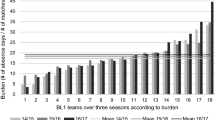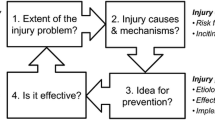Abstract
Purpose
Prospective studies assessing the injuries occurring in elite competitive alpine skiers are lacking, and a full picture of all injuries, including those not requiring medical attention, is absent. Likewise, little is known about the sex-specific injury risks and patterns of elite skiers throughout an entire season (i.e. an off-season preparation period and a competition period). Accordingly, this study investigated the injuries of a national team cohort with respect to season period and sex.
Methods
Over an entire season, all injuries occurring in 44 Swiss National Ski Team members (25 females and 19 males) were registered, regardless of whether they required medical attention. Skiers were prospectively monitored by the Oslo Sports Trauma Research Centre (OSTRC) questionnaire and by continuously updated team medical records. Finally, these data were used as a reference for supplemental interviews, in which the correctness and completeness of the prospective data were verified.
Results
The risk of suffering at least one injury during an entire season was 75.0% with a 95% confidence interval (73.1%, 76.9%) for traumatic injuries, and 52.3% (50.0%, 54.5%) for overuse injuries. Traumatic injuries concerned the head, lower leg and knee, while overuse injuries affected the lumbar spine, knee and hip. During the competition period, skiers were more prone to traumatic injuries, while during the off-season preparation period, skiers’ risk was higher for overuse injuries. Over an entire season, there were no sex differences. However, females were more vulnerable to traumatic injuries during the preparation period and overuse injuries during the competition period, while males had a higher risk for overuse injuries during the preparation period.
Conclusions
When prospectively registering injuries among elite competitive alpine skiers over an entire season, regardless of whether the injuries required medical attention, the injury risks were alarmingly high and substantially larger than those previously reported. Moreover, since injury risks and patterns are season period and sex dependent, it is strongly recommended that (1) injury registration focuses on both the off-season preparation period and the competition period and (2) prevention efforts are specifically tailored to the sex of the athletes.
Level of evidence
II.
Similar content being viewed by others
References
Alhammoud M, Racinais S, Rousseaux-Blanchi MP, Bouscaren N (2020) Recording injuries only during winter competitive season underestimates injury incidence in elite alpine skiers. Scand J Med Sci Sports. https://doi.org/10.1111/sms.13648
Aminoff AS, Agnvall C, Todd C, Jonasson P, Thoreson O, Sansone M et al (2020) Young elite Alpine and Mogul skiers have a higher prevalence of cam morphology than non-athletes. Knee Surg Sports Traumatol Arthrosc 28:1262–1269
Bahr R (2009) No injuries, but plenty of pain? On the methodology for recording overuse symptoms in sports. Br J Sports Med 43:966–972
Bere T, Florenes TW, Krosshaug T, Haugen P, Svandal I, Nordsletten L et al (2014) A systematic video analysis of 69 injury cases in World Cup alpine skiing. Scand J Med Sci Sports 24:667–677
Bere T, Florenes TW, Nordsletten L, Bahr R (2014) Sex differences in the risk of injury in World Cup alpine skiers: a 6-year cohort study. Br J Sports Med 48:36–40
Clarsen B, Bahr R (2014) Matching the choice of injury/illness definition to study setting, purpose and design: one size does not fit all! Br J Sports Med 48:510–512
Clarsen B, Ronsen O, Myklebust G, Florenes TW, Bahr R (2014) The Oslo Sports Trauma Research Center questionnaire on health problems: a new approach to prospective monitoring of illness and injury in elite athletes. Br J Sports Med 48:754–760
Clifton DR, Hertel J, Onate JA, Currie DW, Pierpoint LA, Wasserman EB et al (2018) The first decade of web-based sports injury surveillance: descriptive epidemiology of injuries in US High School Girls’ Basketball (2005–2006 Through 2013–2014) and National Collegiate Athletic Association Women’s Basketball (2004–2005 Through 2013–2014). J Athl Train 53:1037–1048
Engebretsen L, Soligard T, Steffen K, Alonso JM, Aubry M, Budgett R et al (2013) Sports injuries and illnesses during the London Summer Olympic Games 2012. Br J Sports Med 47:407–414
Engebretsen L, Steffen K, Alonso JM, Aubry M, Dvorak J, Junge A et al (2010) Sports injuries and illnesses during the Winter Olympic Games 2010. Br J Sports Med 44:772–780
Florenes TW, Bere T, Nordsletten L, Heir S, Bahr R (2009) Injuries among male and female World Cup alpine skiers. Br J Sports Med 43:973–978
Florenes TW, Nordsletten L, Heir S, Bahr R (2012) Injuries among World Cup ski and snowboard athletes. Scand J Med Sci Sports 22:58–66
Florenes TW, Nordsletten L, Heir S, Bahr R (2011) Recording injuries among World Cup skiers and snowboarders: a methodological study. Scand J Med Sci Sports 21:196–205
Fuller CW, Ekstrand J, Junge A, Andersen TE, Bahr R, Dvorak J et al (2006) Consensus statement on injury definitions and data collection procedures in studies of football (soccer) injuries. Br J Sports Med 40:193–201
Gilgien M, Reid R, Raschner C, Supej M, Holmberg HC (2018) The training of Olympic alpine ski racers. Front Physiol 9:1772
Haaland B, Steenstrup SE, Bere T, Bahr R, Nordsletten L (2016) Injury rate and injury patterns in FIS World Cup Alpine skiing (2006–2015): have the new ski regulations made an impact? Br J Sports Med 50:32–36
Harris PA, Taylor R, Thielke R, Payne J, Gonzalez N, Conde JG (2009) Research electronic data capture (REDCap)–a metadata-driven methodology and workflow process for providing translational research informatics support. J Biomed Inform 42:377–381
Hildebrandt C, Raschner C (2013) Traumatic and overuse injuries among elite adolescent alpine skiers: a two-year retrospective analysis. Int SportMed J 14:245–255
Jordan MJ, Aagaard P, Herzog W (2017) Anterior cruciate ligament injury/reinjury in alpine ski racing: a narrative review. Open Access J Sports Med 8:71–83
Junge A, Langevoort G, Pipe A, Peytavin A, Wong F, Mountjoy M et al (2006) Injuries in team sport tournaments during the 2004 Olympic Games. Am J Sports Med 34:565–576
Klous M, Muller E, Schwameder H (2012) Three-dimensional knee joint loading in alpine skiing: a comparison between a carved and a skidded turn. J Appl Biomech 28:655–664
Knowles SB, Marshall SW, Guskiewicz KM (2006) Issues in estimating risks and rates in sports injury research. J Athl Train 41:207–215
Maxwell N, Redhead L, Verhagen E, Spörri J (2020) Ski racers' understanding of sports-related concussion and its management: are contemporary findings and clinical recommendations reaching the target audience, the racers themselves? Br J Sports Med. https://doi.org/10.1136/bjsports-2019-101544
McCrory P, Meeuwisse W, Dvorak J, Aubry M, Bailes J, Broglio S et al (2017) Consensus statement on concussion in sport-the 5(th) international conference on concussion in sport held in Berlin, October 2016. Br J Sports Med 51:838–847
Müller L, Hildebrandt C, Müller E, Oberhoffer R, Raschner C (2017) Injuries and illnesses in a cohort of elite youth alpine ski racers and the influence of biological maturity and relative age: a two-season prospective study. Open Access J Sports Med 8:113–122
Petersen CL, Gorges M, Dunsmuir D, Ansermino M, Dumont GA (2013) Experience report: functional programming of MHealth applications. In: Proceedings of the 18th ACM SIGPLAN Int Conference on Functional Programming, Boston, Massachusetts, USA
Pujol N, Blanchi MP, Chambat P (2007) The incidence of anterior cruciate ligament injuries among competitive Alpine skiers: a 25-year investigation. Am J Sports Med 35:1070–1074
Spörri J, Kröll J, Fasel B, Aminian K, Müller E (2017) The use of body worn sensors for detecting the vibrations acting on the lower back in Alpine Ski racing. Front Physiol 8:522
Spörri J, Kröll J, Gilgien M, Müller E (2017) How to prevent injuries in Alpine Ski racing: What do we know and where do we go from here? Sports Med 47:599–614
Spörri J, Kröll J, Haid C, Fasel B, Müller E (2015) Potential mechanisms leading to overuse injuries of the back in Alpine ski racing: a descriptive biomechanical study. Am J Sports Med 43:2042–2048
Steenstrup SE, Bakken A, Bere T, Patton DA, Bahr R (2018) Head injury mechanisms in FIS World Cup alpine and freestyle skiers and snowboarders. Br J Sports Med 52:61–69
Steffen K, Soligard T, Engebretsen L (2012) Health protection of the Olympic athlete. Br J Sports Med 46:466–470
Stenroos AJ, Handolin LE (2014) Alpine skiing injuries in Finland - a two-year retrospective study based on a questionnaire among Ski racers. BMC Sports Sci Med Rehabil 6:9
Tarka MC, Davey A, Lonza GC, O'Brien CM, Delaney JP, Endres NK (2019) Alpine Ski racing injuries. Sports Health 11:265–271
Westin M, Alricsson M, Werner S (2012) Injury profile of competitive alpine skiers: a five-year cohort study. Knee Surg Sports Traumatol Arthrosc 20:1175–1181
Zorko M, Nemec B, Babic J, Lesnik B, Supej M (2015) The waist width of skis influences the kinematics of the knee joint in Alpine Skiing. J Sports Sci Med 14:606–619
Acknowledgements
We would like to thank all participants and team staff involved.
Funding
This study was generously supported by the Balgrist Foundation, Swiss-Ski, the “Stiftung Passion Schneesport,” and the “Stiftung zur Förderung des alpinen Skisportes in der Schweiz (SFSS)” as part of the ISPA Project Grant.
Author information
Authors and Affiliations
Contributions
JS conceptualised and designed the study. JS recruited the participants and organised the data collection. WK and JS designed, built and maintained the digital assessment tools. SF, MH, LP and JS collected the data. SF, MH, LP and JS processed the data and performed the statistical analysis. All authors substantially contributed to the interpretation of data. SF, MH and JS drafted the manuscript; all authors revised it critically, approved the final version of the manuscript, and agreed to be accountable for all aspects of the work.
Corresponding author
Ethics declarations
Conflict of interest
The authors have no relevant conflict of interest to declare.
Ethical approval
The current study was approved by the institutional review board of the Balgrist University Hospital and the cantonal ethic committee (KEK-ZH-NR: 2017-01395), and was performed in accordance with the ethical standards as laid down in the 1964 Declaration of Helsinki and its later amendments.
Informed consent
Written informed consent was obtained from all participants.
Additional information
Publisher's Note
Springer Nature remains neutral with regard to jurisdictional claims in published maps and institutional affiliations.
Rights and permissions
About this article
Cite this article
Fröhlich, S., Helbling, M., Fucentese, S.F. et al. Injury risks among elite competitive alpine skiers are underestimated if not registered prospectively, over the entire season and regardless of whether requiring medical attention. Knee Surg Sports Traumatol Arthrosc 29, 1635–1643 (2021). https://doi.org/10.1007/s00167-020-06110-5
Received:
Accepted:
Published:
Issue Date:
DOI: https://doi.org/10.1007/s00167-020-06110-5




